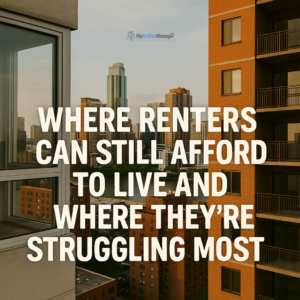As 2024 draws to a close, new data highlights a deepening divide between affordable and expensive rental markets across the United States. According to a new report covered by FOX 9, renters are paying significantly more for housing than just a few years ago and where you live now matters more than ever.
A Quick Look at the Numbers
Zillow’s nationwide rental analysis paints a clear picture: housing costs continue to rise, even as some markets show signs of stabilization.
-
Single-family homes now rent for an average of $2,174 per month, marking a 4.4% year-over-year increase and a staggering 41% jump since before the pandemic.
-
Apartments and multifamily units average $1,812 per month, up 2.4% from the previous year and 26% higher than pre-pandemic levels.
-
To afford the median rent without being considered “cost-burdened,” a renter must now earn $78,592 per year an increase of 3.4% since 2023 and more than one-third higher than before 2020.
These numbers underscore a growing concern: renting, once seen as the flexible and affordable alternative to buying, is becoming less attainable for millions of Americans.
Where Renters Can Breathe Easier and Where They’re Struggling Most
Zillow’s data ranks the most and least affordable cities based on rent-to-income ratios and overall cost burdens.
Most Affordable Cities for Renters:
-
Austin, Texas – A mix of strong job growth and expanded apartment supply has helped keep rents relatively balanced.
-
Minneapolis, Minnesota – Continued development and strong tenant protections have kept rental markets stable.
-
St. Louis, Missouri – A lower cost of living allows residents to stretch their budgets further.
-
Salt Lake City, Utah – Moderate growth and a balanced supply have prevented extreme rent spikes.
-
Milwaukee, Wisconsin – Slow but steady rent increases make it one of the Midwest’s more accessible metro areas.
Least Affordable Cities for Renters:
-
Miami, Florida – Despite cooling slightly, rents remain among the highest relative to income.
-
New York City, New York – Tight supply, strong demand, and limited new construction continue to drive up prices.
-
Los Angeles, California – High land and construction costs keep rental rates elevated.
-
San Diego, California – Desirable coastal location and limited housing inventory push rents upward.
-
Riverside, California – Once considered a more affordable LA alternative, Riverside’s rents have surged as more people move inland.
What’s Behind the Growing Divide?
The growing gap between high- and low-cost rental markets can be traced to several structural factors shaping today’s housing market:
1. Single-Family Homes Are in Short Supply
Post-pandemic lifestyle shifts have created new demand for larger living spaces especially single-family homes. However, the supply of these homes hasn’t kept up. Unlike apartments, which have benefited from record levels of new construction, detached rental homes remain scarce, pushing prices higher.
2. Mortgage Rates Are Keeping Renters in Place
High mortgage rates have locked many would-be homebuyers into renting longer than planned. As a result, demand in the rental market remains elevated, even as affordability declines.
3. Regional Disparities Continue to Widen
Coastal cities like Miami, Los Angeles, and New York remain magnets for jobs and lifestyle seekers, but their housing stock hasn’t grown fast enough to meet demand. Meanwhile, Sunbelt and Midwest metros like Austin, Minneapolis, and St. Louis offer more competitive prices and increasing new construction.
4. Wages Aren’t Keeping Up
While national wages have risen modestly, rent growth has far outpaced income gains since 2020. That means even middle-income earners are spending 30% or more of their paychecks on housing the traditional threshold of affordability.
What This Means for Renters
For renters, understanding these regional dynamics can make a huge difference in long-term housing decisions:
-
Know your numbers: Experts recommend spending no more than 30% of your gross income on rent. In many U.S. metros, this benchmark is now increasingly difficult to achieve.
-
Explore growing markets: Cities in the Midwest and South are still offering better affordability without sacrificing quality of life.
-
Plan for flexibility: Lease terms, roommate arrangements, or co-living options can help offset costs in high-demand areas.
-
Look beyond rent: Transportation, utilities, and local taxes also affect total living costs consider these when comparing locations.
What This Means for Property Managers and Landlords
For property owners and managers, these trends offer both opportunities and challenges:
-
Leverage affordability markets: Cities like Austin and Minneapolis are becoming magnets for renters seeking stability. Offering quality service and maintenance can ensure long-term retention.
-
Strategic pricing matters: In high-cost metros, moderate price adjustments or rent incentives can reduce turnover.
-
Highlight value: With renters becoming more cost-conscious, marketing should emphasize amenities, energy efficiency, and neighborhood convenience.
-
Plan ahead for shifts: If mortgage rates drop and homebuying becomes more accessible, property managers may face greater turnover making proactive engagement even more crucial.
The Bottom Line
The rental market of 2024 is a story of contrasts between cities that have managed to balance growth and affordability, and those struggling under the weight of demand and limited supply.
While national rent growth may be slowing, affordability remains a serious challenge for many Americans. The future will depend on how quickly housing supply can catch up, and how effectively policymakers, developers, and property managers can work together to create a more balanced market.
For renters, staying informed about these trends isn’t just helpful it’s essential. And for property managers, understanding the data behind renter behavior can help guide smarter, more empathetic decisions in the months ahead.
Source: The most and least affordable cities for renters – FOX 9

